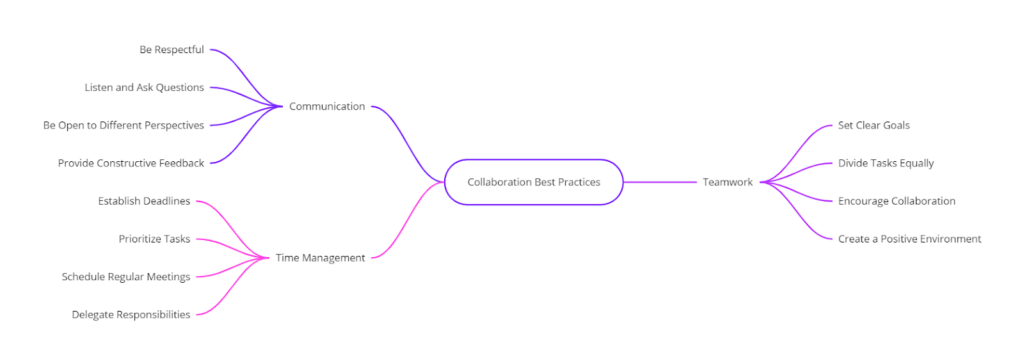The World Economic Forum says the world is moving from competition to collaboration in order to innovate and grow.
The pace of change is accelerating, and collaboration is the key for digital project teams who want to keep up, innovate, and add value to the customer experience. Being able to effectively collaborate will be critical for digital organizations, as it's literally do or die!
10 Effective Team Collaboration Best Practices

When I asked Miro’s AI about collaboration best practices, here’s what I got. Let's explore these in some more practical ways.
1. Establish team norms
Building a team charter or norms doesn’t have to be a complicated undertaking.
For example, I worked with an IT team on strategic planning recently. We found a template for a team norms exercise that had both personal and professional aspects to it. We focused for 15 minutes in each workshop on just completing this team space.
We were able to use this activity as an icebreaker for each of our sessions and at the end of our strategic planning had a team charter to show for it as well—what a great way to build rapport between team members!
2. Invest in effective team collaboration tools
Remote teams call for a complex set of requirements to facilitate effectively—whether or not everyone is working together in real-time. If the remote project team and/or client collaborates across time zones, it may mean they need to be able to operate asynchronously, which will require another layer of complexity not required for remote collaboration.
We need to consider the communication tools and apps we’re using—everything from Slack, messaging, Microsoft Teams, Zoom, Asana, and Confluence through to synchronous and asynchronous considerations around timezones, file sharing, video calls or video conferencing, and in-person meetings.
The reality is, there is not one perfect technology that will work for all teams or all interactions. Teams need to try different collaboration tools and techniques and then iterate.
3. Be respectful
I find the biggest way to demonstrate this is to have meetings that are respectful of people’s time. Start on time, plan an agenda, and end on time! While this may sound simple, I can’t count the number of meetings that don’t apply these principles.
I once had a meditation teacher who pronounced that being late or running late is stealing! After all, what do any of us really have, and our most limited resource is time.
4. Listen and ask questions
How many times do we have one or two personalities dominate meetings, either by their title or by their personality? In a collaborative environment, we need to incorporate techniques that ensure that everyone is heard. After all, if they are in the meeting, we have invited them for their knowledge and/or expertise!
This can be as simple as enforcing team norms of having one conversation at a time, or techniques such as silent brainstorming sessions.
5. Be open to different perspectives
This can mean everything from having different departments and teams represented to having different thinking styles and skill sets deployed. This is critically important when collaborating if you want to get feedback, share knowledge, or engage the group to achieve their common goals.
For example, a meeting being held to develop solutions for a new project or to fix an issue needs to have different perspectives to ensure the solutions are actually going to address the problem and be workable.
Key approaches to this can be to ensure you invite a person from each area impacted or to have small sub groups of the meeting work together to solve the issue and then present back to the group.
6. Provide constructive feedback
When collaborating—whether it's brainstorming, co-creating, decision making, or other activities—people’s passion can help or hinder communication! Best practices here range from meeting norms (ex. in brainstorming there are no bad ideas) to team norms such as responding to people with ‘yes but’ instead of ‘no’.
7. Set realistic deadlines
The key to productive teamwork is to establish an action plan (delegate responsibility) that clearly articulates team goals and, importantly, sets a deadline for it to be completed.
It's important to not fall into the trap of setting a grand vision with an ambiguous date (ie. develop a strategy by Q4). Make it specific and actionable within the next two weeks (ie. the outline of the strategy will be available for review by the team at our next project meeting in 2 weeks).
8. Prioritize tasks
In our fast-paced organizations, things are constantly changing—both within and around our projects. Successful teams not only prioritize tasks within their workflows but continue to revisit current priorities and ensure they are still in-scope and delivering value. In collaborative work, it's just as important to drop activities as it is to add them. Remember: when everything is a priority, nothing is a priority.
9. Schedule regular meetings
Team meetings can really help a project team get into a rhythm. A meeting agenda adds the benefit of streamlining the meetings as the entire team gets into a regular cadence. I recommend that project team leaders set up a standard agenda for a weekly check-in. Here’s my recommended agenda:
Weekly Team Check-In Agenda Template
- Are there any issues with our key dates?
- Are there any issues with our inputs—delays or quality received?
- Are there any issues with our outputs—delays or quality?
- How do we fix those problems?
- Root cause
- Solution evaluation
- Action plan
- Communication plan
- What has been delivered this week—celebrate success!
Having a standard agenda will get your team into a cadence and they will come prepared.
Also, as you get into that rhythm you’ll be able to either streamline the meeting to shorten it or change the focus on to problem solving—both of which respect people’s time!
10. Delegate responsibility
Don’t spend valuable meeting time developing solutions for a particular problem that the entire group doesn’t need to be involved in. I’m not recommending putting teams into silos, but not everyone has to be involved in everything.
For example, if you're collaborating on initiatives to deploy some software or a website, ensure that you have the groups responsible for different aspects prepare their part of the plan and bring it back to the group.
They are the experts in their area—utilize that expertise and then have the team collaborate to integrate the multiple aspects of the plan.
4 Common Barriers To Collaboration
So now that we understand what to do to boost your team’s collaboration, what are the things to watch out for that will sabotage your collaboration! My top three would be:
- Egos: Remember our conversation about competition earlier? If people’s egos or competitive streaks are getting in the way, try setting up meeting norms and team charters.
- Meeting overload: It’s really hard to be creative and collaborate when people are going from meeting to meeting to meeting! Schedule time for breaks between meetings and engage in some icebreakers to get the creative juices flowing prior to the key collaboration activity.
- Lack of trust: Some company cultures still have a competitive environment and there can be a rigid hierarchy and authority levels. This can be debilitating to workplace collaboration and creativity. In this case, promote a culture of collaboration with activities that aren’t threatening and build on them within your project team. Try out some fun team-building activities and retrospectives and build on that!
- Poor communication: When working in collaborative teams, more communication is always better than less. Communication skills are bound to vary across cross-functional teams, so it’s best to establish norms and processes around what effective team communication looks like so everyone has a benchmark.
What’s Next?
I hope these best practices for cross-functional collaboration can help you get more out of your team’s efforts! If you’re experiencing meeting overload, meetings where egos are fighting for attention, or a general lack of trust within your project, try using one of these techniques to get more successful collaboration started.
For more great project insights, subscribe to The Digital Project Manager newsletter!


